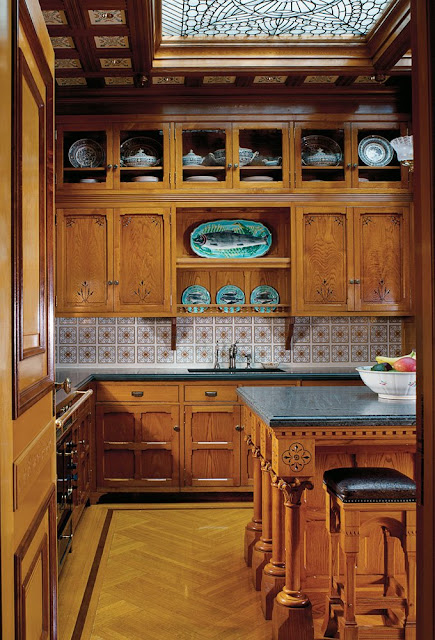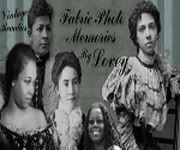The foyer is entered via antique double doors that feature textured-glass panels and cabachon jewels. Colors of the original encaustic tile floor, made by Boch Freres, inspired the palette for the stairwell. Inspired by Bruce Talbert, David Scott Parker designed the sunflower wallpaper the continues up the stairwells linking the floors. The rosewood mirror and gryphon newel lamp are attributed to Herter Brothers.
The Loebs, who share teh 1882 Neo-Gre townhouse with their fourteen year old triplets, restored the residence and furnished it with nineteenth century artwork as well as Aethetic Movement furnishings, fixtures and decorative accessories.
"The house had an astonishing amount of intact original detailing," Michael saays. "The first time I saw it, it took my breath away. I got as far as the dining room and said, 'We've gotta have it.'"
The front parlor, whose walls are upholstered in a custom silk lampas reproduced by Scalamandre from original fragments found in the house, serve as a mini art gallery that includes Julius LeBlance Stewart's "An Interesting Letter and Lady on a Pink Divan." A rosewood pouf with marquetry and brass inlay, attributed to Herts Brothers, is a focal point in the parlor. It is topped with an American Aesthetic Movement silver and brass plated gas newel lamp with candleabra. Edouard Manet's "Woman Leaning on a Garden Vase" hangs next to the mantel.
The couple began collecting nineteenth century American antiques when they were restoring their previous Manhattan townhouse, and this brownstone, the only private house left on the block, gave them the opportunity to edit and upgrade. "We're fascinated by nineteenth century decorative arts," says Margie, "and we were eager for the interiors to be true to spirit of that era, but this is also our home and it had to be a comfortable, practical place to live with our children."
The collecting interests eventually narrowed to focus on the American Aesthetic Movement, the avant-garde, furniture-as-art, British born style popularized by the Philadelphia Centennial Exhibition of 1876. "We are crazy about the Aesthetic Movement," says Margie, and it's premise "that everything should be beautiful. There was nothing that was not decorated to the fullest. I love its of harmoniously combining classical elements with the exotic contemporary cultures of the time from places like Japan."
In one cozy corner of the parlor, a carved maple parlor suite, attributed to Herter Brothers, becomes the landscape for a trio of paintings: Milne Ramsey's "Still Life" (on the Herter Brothers easel), Alfred Thompson Bricher's "In Gloucester Harbor" (top), and "Sunrise on the Coast."
The parlor's curtains are a custom Scalamandre silk lampas, berry & Vine, reproduced from original fabric discovered on the pouf under newer layers of upholstery.
The parlor feature a new pair of twelve arm custom gasoliers designed and manufactured for the project by Quality Lighting. This corner of the parlor features another parlor suite attributed to the Herter Brothers.
The parlor feature a new pair of twelve arm custom gasoliers designed and manufactured for the project by Quality Lighting. This corner of the parlor features another parlor suite attributed to the Herter Brothers.
The magnificent Renaissance Revival rosewood cabinet at the end of the parlor was created by the Herter Brothers in the early 1870's.
They enlisted architects David Scott Parker and John Wasilewski, historic interior consultant Mimi Findlay and Traditional Line builder Anthony Lefeber to research, restore, and seamlessly update the period residence.
The house had incurred miscellaneous modifications through its many decades, and the Loebs decided to retain some of the more sympathetic alterations. They opted to keep the first floor dining room, which was created in 1889 by converting the rear half of the double parlor. The elevator was allowed to stay, but it was enlarged without making significant changes to the home's floor plan.

The first floor dining room with original rosewood ceiling and impressive collection of Minton vases and vessels designed by John Moyere Smith for the 1878 Paris Exhibition.
The music room leads to the master suite dressing rooms, which retain theeir original carved maple woodwork. A six piece set of four arm cast brass and Longwy tile chandeliers lead to the master bedroom. One is an antique; the other were fabricated under the direction of Mimi Findlay and include new tile elements reproduced by the original factory iin Longwy, France. (right) A corner of the master bedroom, glimpsed through a protiere, features a Herter Brothers rosewood recamier and Charles Courntey Curran's "Green Lattice," 1919.
To bring the brownstone up to contemporary standards, they installed state-of-the-art heating and cooling systems and lighting control technology that incorporates antique gasoliers while accommodating twenty-first century expectation for ambient light. "They didn't want to live in a dark house," Parker says. "We strategically positioned concealed lighting into the ceiling papers so that every fixture aligns discreetly within a decorative motif.
Margie points out that this was quite a feat, because the lights had to be installed before the paper was even designed. One of the greater challenges was undertaken by Findlay: It fell to her to locate more than two hundred appropriate period lighting fixtures. In the suite, for instance, one of the six matching enfilade chandeliers is an antique; the others are carefully crafted replicas. Acquiring enough antique etched glass shades for the chandeliers was yet another task.
"We found a guy in the Mohave Desert who was selling his collection of five hundred," Margie says. "He spent his whole life collecting them. It took some doing - he was rather eccentric and refused to ship anything. We had to send a lighting consultant on the West Coast to hand-select, pack, and drive the shades cross country to us. Not a single one broke. Then we had to match them all up to chandeliers. Even then, we didn't have enough for all of them to match on every fixture, so we chose ones that were close in design and put them together."
Although the mantle remained, the overmantel in the master bedroom had been removed in the twentieth century. Shadows on the plaster gave clues for its recreation. Its shelves display a few of the Loeb's Chrisopher Dresser designed Minton vases. Richard Edward Miller's "Seated Lady with Red Hair" hangs to the right.
They concentrated on museum quality pieces, notably magnificent furnishings by Herter Brothers, ceramics by Christopher Dresser, and stained glass windows by Louis Comfort Tiffany. They bought paintings by Hudson River School artists Thomas Moran, Alfred Thompson Bricher, and Albert Bierstadt; orientalist works by Edwin Lord Weeks; landscapes by William Merritt Chase; and portraits of women by Charles Webster Hawthorne and Edouard Manet. They arranged and hung by subject category, effectively creating mini galleries in every room. In essence, the house has become a work of art, their period piece so to speak.
Originally a nursery, this space is now Margie Loeb's dressing room. A rare antique glass-tile window made by Louis Comfort Tiffany illuminates the room, which is appointed with a custom white marble tub by Elizabeth Street.
The wallcoverings were either reproduced from the originals or custom designed by Parker and his associates and were made to look as they would have when they were created - not bleached, faded or worn by time. Rather than incorporate bronzing powders, several wallpapers were printed on gold leaf so won't ever inevitably lose their luster. Woodwork throughout the house was restored and French polished. Missing pieces were carved to match and complement the originals; there was enough work to keep two carvers busy for five years. "It's the attention to detail that takes the house to another level," Parker says, adding that on innumerable days more than a hundred artisans and skilled craftsmen could be found working throughout the home.
The fourth floor family room began its life as servant quarters. It's appointed in the Modern Gothic taste. The Knole sofa and settee were custom designed based upon plates in Charles Locke Eastlake's Hints of Household Taste. The large oak sideboard is attributed to Herter Brothers and features exquisite foliate relief and figural carvings. In a nod to the children of the house, the antique linen curtains illustrate the tale of Aladdin's lamp with scenes attributed to Lewis Day.
The couple's quest to reestablish the past glory of the brownstone was all the more urgent because of the nine adjacent originally built, only two remain. The other one, to which the Loeb house is attached like a Siamese twin, has been completely stripped of its exterior ornament and charm and painted white. Only the ghosts of it's former fabulous facade are visible.
The Neo-Grec brownstone, one of nine on the Upper East Side block, was built in 1882 on lad acquired from Charles Comfort Tiffany, father of Louis Comfort Tiffany. In addition to careful restoration of the brownstone facade, a stained glass-enclosed rooftop conservatory was added at the rear of the building.
Adjacent to the family room, the kitchen continues the Modern Gothic theme, this time with chestnut cabinetry designed by the Parker firm. The space is flooded with natural light from an antique four panel textured glass skylight.
The children's rooms are on the floor above with ample space where they gather to do their homework.Originally staff quarters, the top floor, which includes the kitchen and the family room, is now the heart of the home. At some point in time, it had been turned into a generic modern white on white apartment. Because there was no existing woodwork, it afforded the opportunity to create a different look and they chose the Modern Gothic style.
The Loebs don't see their collection as mere art objects. Each piece has meaning, not to mention rare beauty. Each room has its own personality, so it's hard for them to play favorites. Margie, however, is partial to the Moorish-style library, a cozy corner that is off the dining room. It is appointed with a Hunzinger parlor set that they brought over from their previous house features a Tiffany Studios wisteria window and series of paintings done by Edwin Lord Weeks during a trip to India.
A period stained glass lay light sporting signs of the zodiac top the stair hall, replacing a modern roof fire stair. The change opened up the space for artwork, which includes Charles Caryl Coleman's "Twilight and Poppies," 1889.
The Loebs regard their brownstone as a work in progress and don't mind the notion that it may never be finished. As she walks up the stairs to her office, Margie comments that there is still more space on the wall of the upper landings.
"Every time I look at the artwork, furnishing and finishes through the house, I see something new and beautiful," she says. "And that's saying a lot because I'm seeing them every day."
Be sure to check out the offerings from the participants on todays Beverly's Pink Saturday Blog Hop!
Now, you go make something beautiful!
Be sure to check out the offerings from the participants on todays Beverly's Pink Saturday Blog Hop!
Now, you go make something beautiful!
´¨)
¸.•´¸.•*´¨) ¸.•*´¨)
(¸.•´ (¸.•´? Tristan
¸.•´¸.•*´¨) ¸.•*´¨)
(¸.•´ (¸.•´? Tristan
The top-floor conservatory was added by the Loebs. It features a white marble and peacock eglomise mosaic fountain attributed to Tiffany Studios and a rare set of English Aesthetic Movement stained glass windows depicting signs of the zodiac to complement the theme of the adjoining star-hall lay light.




































































































3 comments:
Are you freaking kidding me??? The opulence and grandeur of this home are out of this world!! What on earth type of incomes these people must have to be able to afford such renovations? I do hope this place is put in a trust or preservation so it may one day be viewed by the less fortunate(me) hehee
Tristan, I have no idea where you find these gems, but I thank you for sharing! I almost chocked on my coffee though, when I read about the glass from the Mohave Desert!
Jackie xx
This is fabulous. I really admire them bringing it back -- it's gorgeous. And yes, as Jackie said, they must have one mega-income. This one is a stunner.
... testing notification system ...
Post a Comment